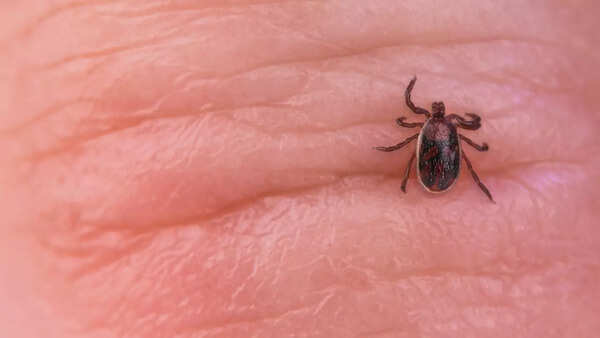Maria Palen, a 31-year-old chemical engineer and fitness enthusiast from California, embodied health and wellness. With a dedicated plant-based diet, regular exercise, and a thriving Instagram community of over 20,000 followers, her life seemed to revolve around peak physical condition. However, a sudden turn of events transformed her narrative from one of fitness triumph to a harrowing health crisis.
After experiencing months of unexplained joint pain, swelling, and persistent fatigue, Maria received a diagnosis of babesiosis. This infection, caused by parasites transmitted through tick bites, ultimately led to paralysis from the waist down by late 2024.
This unexpected journey underscores a crucial lesson: outward appearances can be deceiving, and invisible threats can silently undermine our health. Maria's story serves as a stark reminder of the potential dangers lurking within tick-borne illnesses, particularly for those who frequently engage with the outdoors.

Initially, Maria's symptoms were subtle: inflammation, joint discomfort, and a persistent thumb pain. In an effort to alleviate these issues, she adopted a stricter diet and intensified her exercise regimen. Regrettably, her condition deteriorated despite these efforts.
By March 2024, Maria found herself largely confined to bed. Simple tasks such as using her phone or opening a can of tuna became significant challenges.
Eventually, a functional medicine specialist identified the root cause of her suffering: babesiosis. This relatively obscure tick-borne disease is triggered by Babesia parasites, which invade and infect red blood cells. Unlike the more widely recognized Lyme disease, babesiosis often evades early detection due to its symptoms resembling common ailments like the flu or general fatigue. According to the Centers for Disease Control and Prevention (CDC), the incidence of babesiosis has doubled in the past decade, surging from 1,000 cases in 2011 to approximately 2,500 cases annually today.
Maria suspects that she may have been bitten by an infected tick years prior, potentially during a hiking excursion, without ever noticing it. Over time, the infection gradually progressed, ultimately impacting her nervous system. By October 2024, she was unable to sit comfortably due to excruciating tailbone pain, which was quickly followed by the onset of paralysis.
Tick bites are frequently overlooked. Their small size and painless nature make them easy to miss. Compounding the issue is the extended latency period that some infections can exhibit. Maria's experience highlights the critical need for greater awareness and understanding of lesser-known tick-borne diseases such as babesiosis.
Ticks are most prevalent during the warmer months and thrive in environments with abundant grass or woodland. The 2024 tick season in the United States was particularly severe, as milder winters resulted in increased survival rates for various animal species that serve as tick hosts. Researchers at the University of California, Riverside, have noted that this surge in tick populations elevates the risk of rare infections spreading unnoticed.
The microbes responsible for babesiosis (Babesia microti and B. duncani) are difficult to detect because they reside within red blood cells. Recent research that successfully decoded the genome of B. duncani revealed that its behavior is similar to the parasite responsible for malaria, explaining why initial symptoms can include fever, chills, and muscle aches before progressing to more severe complications.
Maria's story is compelling, not only because of the hardship she has endured, but also because of her incredible spirit. Despite undergoing eight hours of therapy each week, she remains optimistic about regaining feeling in her legs.
Her experience underscores a vital point: early detection is paramount in managing tick-borne illnesses.
While doctors commonly test for Lyme disease when a tick-borne illness is suspected, babesiosis is not always considered. Given that these conditions can coexist, symptoms may be misattributed. Therefore, it is imperative that healthcare providers adopt a broader diagnostic approach and that individuals diligently monitor any unexplained changes in energy levels, muscle strength, or instances of chronic pain, especially after spending time outdoors.
The risk extends beyond hiking or camping. Even activities like gardening in overgrown backyards or walking through wooded areas can pose a threat, particularly when appropriate protective measures, such as wearing protective clothing or applying tick repellents, are not taken.
Most standard recommendations include advice such as "wear long sleeves" and "check for ticks." However, Maria's case necessitates a more comprehensive approach:
[This article is intended for informational purposes only and is not a substitute for professional medical advice. For any symptoms or health concerns, please consult a licensed healthcare provider]
Newer articles
Older articles
 India Enters New Space Age as Astronaut Shukla Joins ISS Mission
India Enters New Space Age as Astronaut Shukla Joins ISS Mission
 X Cracks Down: Half a Million Indian Accounts Suspended for Policy Breaches
X Cracks Down: Half a Million Indian Accounts Suspended for Policy Breaches
 Google Unveils Strategy to Combat Misinformation, Boost Voter Access in India's 2024 Elections
Google Unveils Strategy to Combat Misinformation, Boost Voter Access in India's 2024 Elections
 Hair Oil vs. Hair Serum: Which is the Right Choice for Your Hair?
Alternatively:
Unlock Your Best Hair: Choosing Between Hair Oil and Serum for a Healthy Mane
Hair Oil vs. Hair Serum: Which is the Right Choice for Your Hair?
Alternatively:
Unlock Your Best Hair: Choosing Between Hair Oil and Serum for a Healthy Mane
 Vijay Sethupathi Apologizes Amid Controversy Over Son's Film 'Phoenix'
Vijay Sethupathi Apologizes Amid Controversy Over Son's Film 'Phoenix'
 Bollywood's 'Swades' Anthem Joins Axiom-4 Mission: Indian Astronaut's Playlist Honors Heritage in Space
Bollywood's 'Swades' Anthem Joins Axiom-4 Mission: Indian Astronaut's Playlist Honors Heritage in Space
 New York Assemblyman Zohran Mamdani's Style: 5 Lessons in Authenticity and Heritage
New York Assemblyman Zohran Mamdani's Style: 5 Lessons in Authenticity and Heritage
 Colon Cancer: Don't Ignore These 5 Early Warning Signs
Colon Cancer: Don't Ignore These 5 Early Warning Signs
 TSMC Regains Top 10 Global Value Ranking Amid AI Boom
TSMC Regains Top 10 Global Value Ranking Amid AI Boom
 Android Users Urged to Update Devices Amid High-Severity Security Flaws: Government Issues Warning
Android Users Urged to Update Devices Amid High-Severity Security Flaws: Government Issues Warning